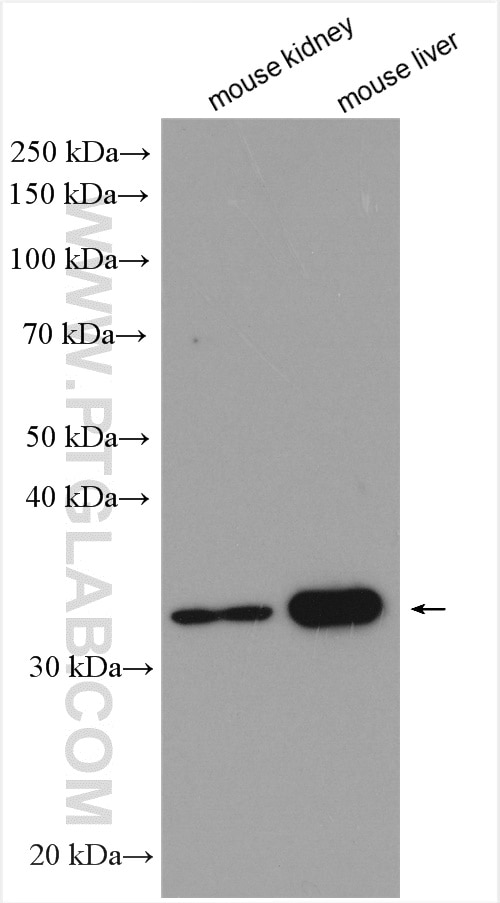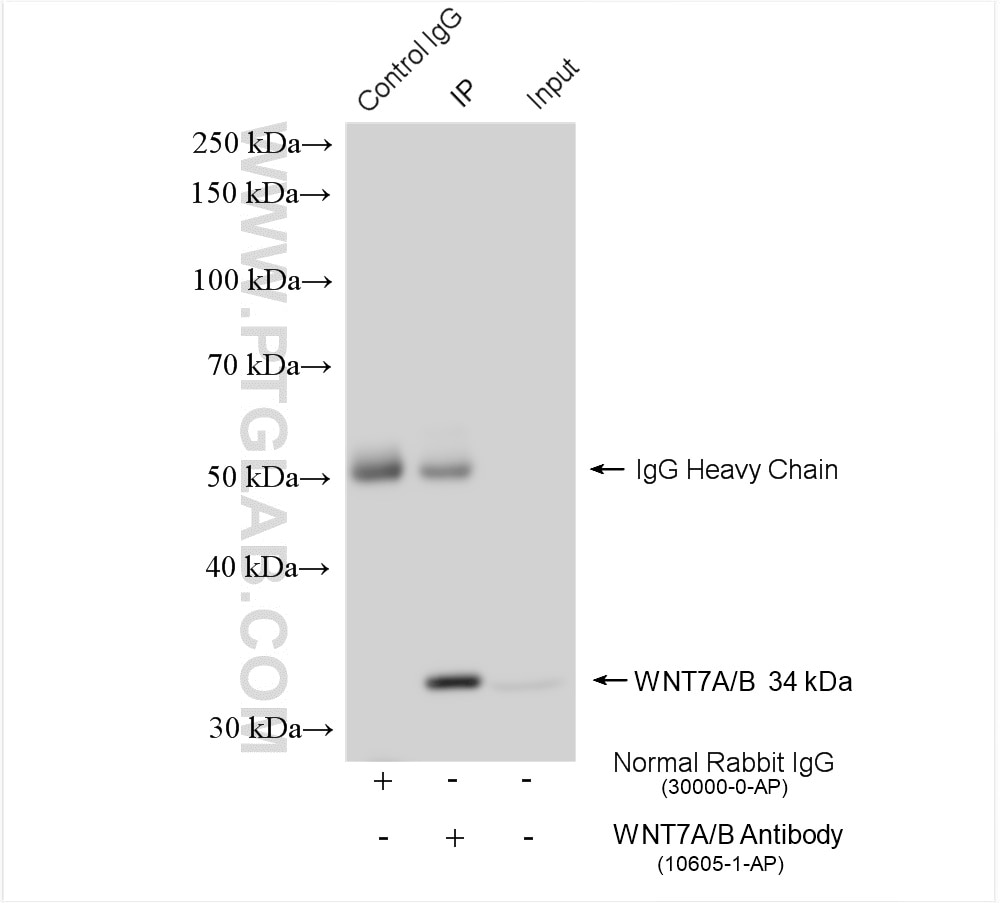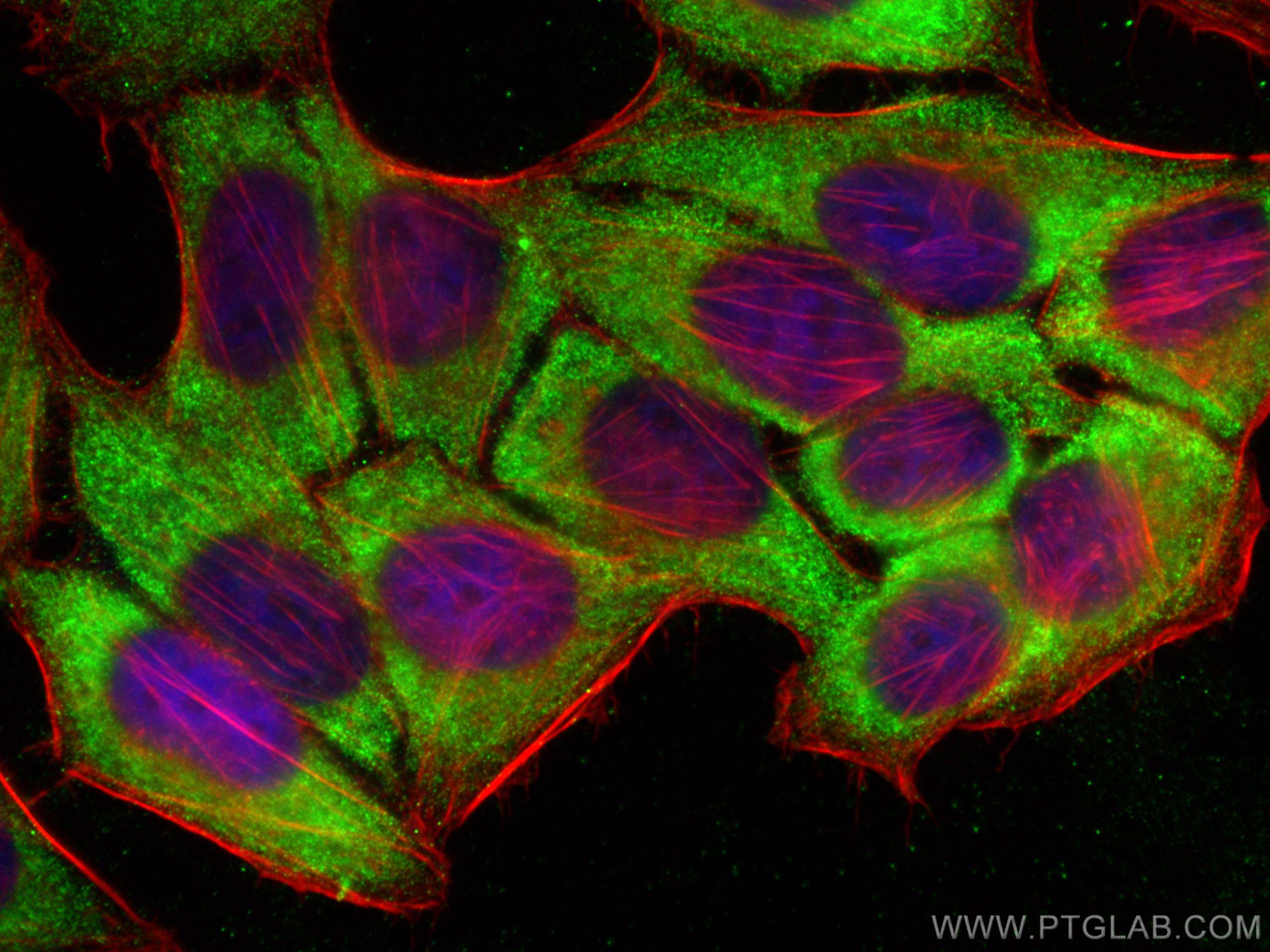- Featured Product
- KD/KO Validated
WNT7A Polyklonaler Antikörper
WNT7A Polyklonal Antikörper für WB, IF/ICC, IP, ELISA
Wirt / Isotyp
Kaninchen / IgG
Getestete Reaktivität
human, Maus, Ratte
Anwendung
WB, IHC, IF/ICC, IP, ELISA
Konjugation
Unkonjugiert
Kat-Nr. : 10605-1-AP
Synonyme
Galerie der Validierungsdaten
Geprüfte Anwendungen
| Erfolgreiche Detektion in WB | Mausnierengewebe, Mauslebergewebe |
| Erfolgreiche IP | Mausnierengewebe |
| Erfolgreiche Detektion in IF/ICC | HepG2-Zellen |
Empfohlene Verdünnung
| Anwendung | Verdünnung |
|---|---|
| Western Blot (WB) | WB : 1:500-1:2000 |
| Immunpräzipitation (IP) | IP : 0.5-4.0 ug for 1.0-3.0 mg of total protein lysate |
| Immunfluoreszenz (IF)/ICC | IF/ICC : 1:50-1:500 |
| It is recommended that this reagent should be titrated in each testing system to obtain optimal results. | |
| Sample-dependent, check data in validation data gallery | |
Veröffentlichte Anwendungen
| KD/KO | See 1 publications below |
| WB | See 8 publications below |
| IHC | See 5 publications below |
| IF | See 2 publications below |
Produktinformation
10605-1-AP bindet in WB, IHC, IF/ICC, IP, ELISA WNT7A und zeigt Reaktivität mit human, Maus, Ratten
| Getestete Reaktivität | human, Maus, Ratte |
| In Publikationen genannte Reaktivität | human, Maus, Ratte |
| Wirt / Isotyp | Kaninchen / IgG |
| Klonalität | Polyklonal |
| Typ | Antikörper |
| Immunogen | WNT7A fusion protein Ag0874 |
| Vollständiger Name | wingless-type MMTV integration site family, member 7A |
| Berechnetes Molekulargewicht | 39 kDa |
| Beobachtetes Molekulargewicht | 30-39 kDa |
| GenBank-Zugangsnummer | BC008811 |
| Gene symbol | WNT7A |
| Gene ID (NCBI) | 7476 |
| Konjugation | Unkonjugiert |
| Form | Liquid |
| Reinigungsmethode | Antigen-Affinitätsreinigung |
| Lagerungspuffer | PBS mit 0.02% Natriumazid und 50% Glycerin pH 7.3. |
| Lagerungsbedingungen | Bei -20°C lagern. Nach dem Versand ein Jahr lang stabil Aliquotieren ist bei -20oC Lagerung nicht notwendig. 20ul Größen enthalten 0,1% BSA. |
Hintergrundinformationen
The Wnt gene family encodes secreted signaling molecules that bind to frizzled receptors and influence oncogenesis and developmental processes, including regulation of cell fate and patterning during embryogenesis. Wnt7a is normally expressed in several organs, including the lung, testis, lymph node, and brain. As an oncogenic autocrine glycoprotein, Wnt7a promotes tumor invasion and distant metastasis with cancer-associated fibroblasts. Wnt7b is required for endothelial cells derived from pluripotent stem cells to acquire blood-brain barrier properties and may play an important role in the development of myopia in humans. This antibody can both recognize WNT7A and WNT7B.
Protokolle
| Produktspezifische Protokolle | |
|---|---|
| WB protocol for WNT7A antibody 10605-1-AP | Protokoll herunterladen |
| IF protocol for WNT7A antibody 10605-1-AP | Protokoll herunterladen |
| IP protocol for WNT7A antibody 10605-1-AP | Protokoll herunterladen |
| Standard-Protokolle | |
|---|---|
| Klicken Sie hier, um unsere Standardprotokolle anzuzeigen |
Publikationen
| Species | Application | Title |
|---|---|---|
Front Oncol The Role of miR-640: A Potential Suppressor in Breast Cancer via Wnt7b/β-catenin Signaling Pathway. | ||
Oncol Rep Wnt7a predicts poor prognosis, and contributes to growth and metastasis in tongue squamous cell carcinoma.
| ||
Behav Brain Res OGDHL ameliorates cognitive impairment and Alzheimer's disease-like pathology via activating Wnt/β-catenin signaling in Alzheimer's disease mice. | ||
Oncol Rep RNA-binding motif protein 5 negatively regulates the activity of Wnt/β-catenin signaling in cigarette smoke-induced alveolar epithelial injury. | ||
Neurol Res Wnt signaling pathway is involved in the pathogenesis of amyotrophic lateral sclerosis in adult transgenic mice. | ||
NAR Cancer EVI1 activates tumor-promoting transcriptional enhancers in pancreatic cancer. |




